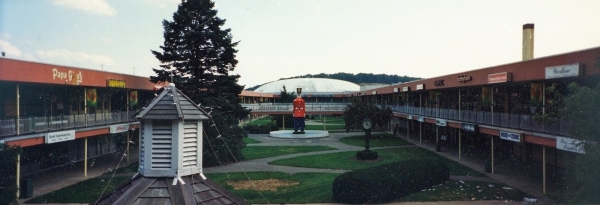BRATTLEBORO — The assault on local retail began with the Sears catalog. Unless things change, it will be finished by Amazon.
A big change in U.S. rural life began in 1913 with the introduction of Rural Free Delivery. This change paved the way for retail's decline, which has happened in several distinct phases.
* * *
Phase 1: A forebear of Sears, in business since 1886, adopted the Sears Roebuck Co. name in 1893. Catalog sales began in 1888, and by 1895 sales of a large variety of goods totaled $800,000.
But, with RFD, sales exploded, in 1920 totaling $235 million.
Sears was a godsend to rural families, supplying more goods than they could imagine at lower prices than local stores. But to those local stores, Sears was anything but a godsend.
First to go was the general store. Other stores faltered, too, undercut not only by Sears' prices but by the company's Easy Payment Plan (1940) and the low wages it paid employees.
Still, most Main Streets survived, saved by the spread of railroads and rapid growth of population.
* * *
Phase 2: The next major injury to Main Street - this time permanent - was a rapid spread of outskirts commerce.
Starting in the mid-1900s, as more and more people owned cars, businesses sprouted at the edge of town. McDonald's appeared in 1948; Dunkin' Donuts, in 1950. Car dealers and automotive services liked the open space. The first drive-in movie appeared in 1949.
And local businesses moved from Main Street to where space was cheaper and parking easy. Downtowns were hollowed out.
At the same time, the Interstate Highway System was spreading, enabling travelers to bypass Main Street after Main Street.
* * *
Phase 3: Soon, the enclosed shopping mall appeared.
A pioneer was Shoppers' World, with its iconic dome on route 9 west of Boston. It opened in 1951 with Jordan Marsh as anchor store.
Indoor malls then sprouted everywhere, at the edge of larger towns or strategically placed to draw shoppers from several towns. Unlike Main Streets, these malls tended to be indistinguishable: clean but characterless, with mostly chain stores for the middle class.
The extreme is the Mall of America in Minnesota, opened in 1992. Its 96 acres of floor space house more than 530 stores, an amusement park, a wedding chapel, an aquarium, and an 18-hole miniature golf course. It has 11,000 employees and 13,700 parking spaces, and it draws visitors from around the world.
Malls wreaked havoc with the retail economies of Main Streets and closed city downtowns across the country. And now they are on the way out. Of the roughly 1,200 in the U.S., more than half are expected to be gone in five years.
Two things have killed them.
* * *
Phase 4: Malls and downtowns were soon losing ground to big-box stores. Home Depot, Best Buy, Borders Books, Toys R Us, and others opened - again, outside of town.
In addition to the specialized big-box stores, there were “everything” big-box stores - especially Walmart, incorporated in Arkansas in 1969.
By 1990, the chain had become the largest retailer in the U.S. Today, it is the largest in the world, with 11,718 stores, 2.3 million employees, and revenue of approximately $480 billion. Its “Supercenters” sell everything from clothes, plants, toys, and drugs to guns, groceries, auto services, and health care.
It's done more than anything else so far to decimate small town Main Streets.
* * *
Phase 5: As devastating to Main Street as Walmart, and growing faster, is the internet. Data are hard to find. But the evidence from merchants is clear.
Internet sales are the penultimate threat to local retail.
From the comfort of your home, you can buy anything.
* * *
Phase 6: But the internet is not the ultimate threat. The ultimate threat is Amazon.
That company has made itself the master retailer, capturing now almost half of all the money we spend online.
Amazon uses tactics similar to Walmart's and Home Depot's to sideline retailers that resist their pricing pressure. For independent retailers, Amazon regularly raises its fulfillment fees, adding steep charges for warehousing and shipping. (It intends to build its shipping and delivery abilities to overtake UPS.)
To compete with recalcitrant retailers, Amazon now manufactures its own goods. Its information systems are cutting edge. And its robotics program will further reduce the need for employees - already, it employs only half as many people as those needed in traditional stores.
Between 2007 and 2017, Sears, JC Penney, Kohl's, and Macy's all lost more than 40 percent of their business. Amazon's increased 1,318 percent.
You finally won't need a store or a search engine. The aim is that we all will just type in “Amazon.” This condition cries out for antitrust enforcement, but with our present leadership in Washington that scenario has no chance.
* * *
First Sears, and then the spread of “outskirt” commerce, interstates, malls, and big-box stores (especially Walmart), decimated Main Streets and small towns.
The damage isn't visible from the coasts. It's inescapable in the heartland.
From the Rockies to Appalachia, west Texas to North Dakota, dead small towns are everywhere. Towns that are county seats have fared a little better. But elsewhere, in countless towns, the scene is the same: empty streets and storefronts, and young people gone, if they were able to leave.
There have been other causes of the death of our Main Streets, including large changes in agriculture. But soulless mega-retail is largely to blame.
And the damage is no longer mostly in small towns. With phases 5 and 6 - the internet and Amazon - local retail everywhere is endangered. City department stores are mostly gone; now, other urban retail is hard pressed.
Amazon is gluttonous and destructive. It needs our attention.
